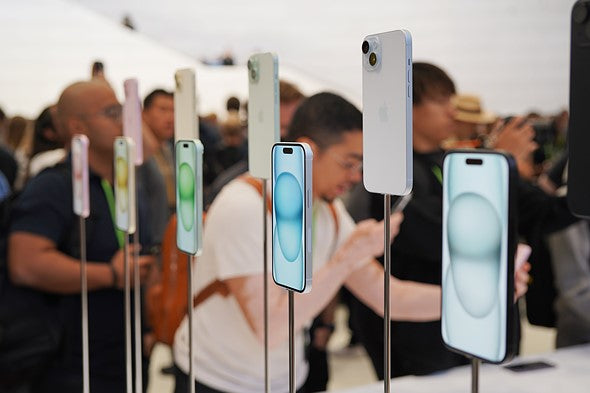
iPhone 15 cameras: What you need to know
Share
iPhone 15 Cameras
The main camera’s 26mm-equivalent lens is slightly slower at f/1.6 compared to the iPhone 14’s f/1.5. The wide and front cameras remain the same across generations, with 12 MP resolutions and apertures of f/2.4 (wide) and f/1.9 (front).
The main camera in the iPhone 15 and iPhone 15 Plus now includes a 48 MP sensor, up from the 12 MP of the iPhone 14. The camera defaults to capture pixel-binned 24 MP images, which Apples claims allows for more dynamic range and sharpness using their Photonic Engine and updated Smart HDR 5 (the two technologies computationally combine exposures).
Images can also be captured at the full 48 MP and saved as HEIF files; previously, when using the built-in Camera app, 48 MP was available only when shooting in Apple ProRAW on an iPhone 14 Pro through the main camera. (The iPhone 15 does not support ProRAW, however.)
According to Apple the increased resolution also enables a new 2x zoom option, which records the middle section of the sensor to create a 12 MP image. In earlier models, the telephoto camera was one of the features that convinced people to move up to the Pro line, so it’s nice to see that as an option here on lower tier models.

Image Credit: Tucker Bowe
iPhone 15 Pro Cameras
The iPhone 15 Pro retains the same main 24mm f/1.78 lens and sensor (2.44 µm quad pixel) as the iPhone 14 Pro. The default capture mode is 24 MP pixel-binned images (up from 12 MP in the iPhone 14 Pro), but you’ll also be able to take full 48 MP photos as HEIF images, not just ProRAW. The wide (13mm) and telephoto (77mm) cameras are the same as the iPhone 14 Pro.
The iPhone 15 Pro Max once again brings us back to making a choice between a camera feature and not just a screen size. The Pro Max has a telephoto camera capable of 5x optical zoom, or 120mm equivalent, (the iPhone 15 Pro retains the prior 3x telephoto range) and does it by employing a tetraprism design.
Standard telephoto lenses bend light through multiple lens elements, which requires physical space between the opening and the camera sensor. And although the iPhone camera bumps have risen in recent years, they’re not high enough to accommodate a 120mm zoom.
To have the separation needed for a longer focal length without adding bulk to the camera bump, Apple used a tetraprism to bounce the light four times before reaching the sensor. It’s a smaller design than the periscope design used by other camera makers (who have offered longer telephoto options for several years).

Image Credit: Tucker Bowe
New behaviors for zoom presets on Pro phones
Apple has taken the 2x zoom ability, which uses a portion of the 48 MP main camera sensor, and expanded on the concept by offering multiple focal lengths in the iPhone 15 Pro models. With an assist from its Photonic Engine technology, you can specify focal lengths of 24mm, 28mm or 35mm by tapping the 1x zoom button to reveal those options. Is 35mm your favorite? That can be set as the default option for the 1x view.
Image Credit: Apple
A new approach to Portrait mode
The iPhone’s Portrait mode simulates the type of shallow depth of field used in portraits, with creamy backgrounds and in-focus subjects, but until now it’s always been a separate mode you have to invoke.
In the iPhone 15 and iPhone 15 Pro models, when the camera detects a person, cat or dog in the frame, it automatically switches to Portrait mode and captures the image with an automatically generated depth map. The experience is similar in behavior to how the Macro mode appears when the camera detects close-up objects, with a ƒ button lighting up to indicate the mode is active.
That depth map is what creates the soft focus in the background, which in current models you can adjust while editing to change the simulated aperture. In the new phones, you can also choose to focus on something else–like a person behind the subject–and shift the focus entirely, blurring the subject.

Lens coatings
In a small update sure to bring JJ Abrams to tears, the lenses in the new iPhone 15 and iPhone 15 Pro cameras include an extra coating designed to reduce lens flare, which has tended to be dramatic in iPhone photos for several generations (and as seen in the image above, taken with an iPhone 14 Pro).

Image Credit: Jeff Carlson
Oh say can you USB-C
One of the main architectural changes of the iPhone lineup is the replacement of the Lightning connector with USB-C. For the iPhone 15 Pro models, this move heralds (at last) faster USB 3 data throughput of up to 10 Gbps (when you use an optional cable capable of those speeds, the cable included with the iPhone is limited to USB 2, 480 Mbps, speeds).
The iPhone 15 and iPhone 15 Plus models are only capable of USB 2 throughput.
The USB-C connector will enable you to fast charge the iPhone models at 20W to reach 50% charge in 30 minutes, which is certainly good news to video shooters who may find themselves low on power. And speaking of charging, you can power up an Apple Watch or AirPods Pro case directly (and presumably other devices, but those were the only ones cited by Apple) from the iPhone.
 Image Credit: Tucker Bowe
Image Credit: Tucker Bowe

